Born on October 8, 1926, and died on June 20, 2007, was an American sculptor and ceramicist who was most known for his figurative ceramic containers and sculptures. Rudy’s early pots reflected abstract expressionism, he is best known for his later figurative work which left an indelible mark on art. Autio is considered one of the most influential and inspiring artists to ever touch clay.
He was born Arne Rudolph Autio to a family of Finnish immigrants in Butte, Montana (his native state throughout most of his career) and grew up to be known as Rudio Autio. As a child, he first learned to draw by attending evening sessions taught by artists employed by the Works Progress Administration in Butte, Montana. During World War II, he served in the Navy for a total of two years.
Career
Rudy Autio is regarded as one of the most accomplished and important ceramic artists working in the United States at present.
Throughout his more than fifty-year career, Rudy Autio has established himself as one of the best ceramic artists in the United States. There would be no complete collection of iconic clay artworks developed after 1945 unless it included at least one of his “women and horses” pots.
His most well-known work was innovative, and he, together with a small handful of other forefathers, established the framework for contemporary ceramics in the United States and around the world.

Autio, on the other hand, was more than just a disruptor, creating something new by openly opposing old conventions and norms. His work has a timeless quality to it, which I admire. When it glances back, it does it at the same time that it looks ahead. It has a basic appeal, is friendly, and even plain-spoken. Now, 13 years after his death and nearly 70 years after he first made his mark on the art world, Autio’s work remains intriguing, multitudinous, and lovely in its simplicity.

Following the war’s conclusion, he went on to study art at Montana State University (thanks to the GI Bill), also known as Montana State College, in Bozeman, where he met Peter Voulkos, who would go on to become a lifetime friend of his. Frances Senska was the teacher for both of them.
After finishing his first year of graduate studies at Washington State University, he returned to Montana in the summer of 1951. The Western Clay Manufacturing Company, based in Billings, Montana, employed him.
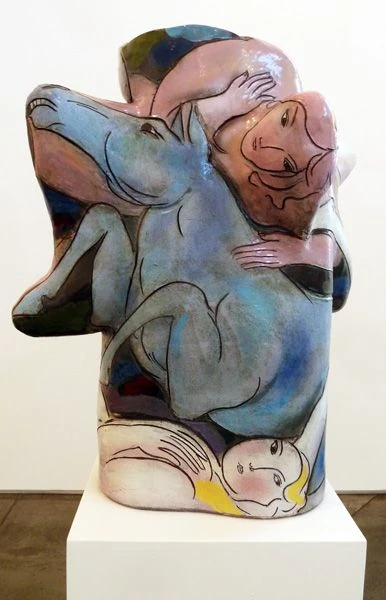
Autio’s friend Peter Voulkos had organized the project, and he had traveled to the spot with another young artist, Kelly Wong, to assist him. Archie Bray, an art enthusiast, and philanthropist had the vision to create a small arts center on the site of his brickyard. In his endeavor, he was successful.
It was a summer of hard work in the brickyard, building pottery, and designing pots that would be fired in the large beehive brick kilns on the property for Autio, Voulkos, and Wong. Autio and Voulkos returned to their studios in the fall after completing their MFAs at their respective graduate institutions. Their residency at the Archie Bray Foundation prompted them to return to Helena for a second time during the summer of 1952 as Artists in Residence.
The trustees of the Bray Foundation organized the first and most famous workshop in the fall of 1952, which featured Bernard Leach, a master craftsman known as the “Father of British studio pottery,” Shiji Hamada, a leading figure in the Japanese mingei folk-art movement, and Soetsu Yanagi, a visiting lecturer in Zen philosophy at Harvard University.
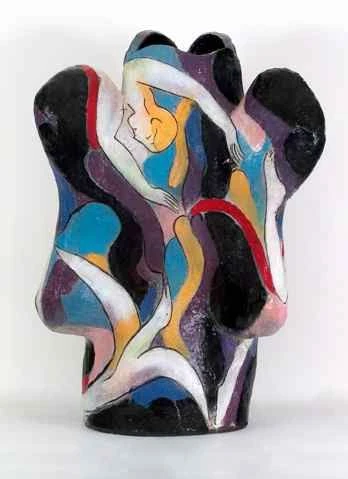
Bernard Leach is renowned as the “Father of British Studio Pottery,” and Shiji Hamada is known as the “Father of Japanese Studio Pottery.” Over the course of two weeks, the guests exhibited pot-throwing and decorating techniques, as well as discussed the historic practices they were preserving.
For Autio and the foundation, the following year, 1953, was a watershed moment in their history. Archie Bray was hurt in the brickyard early in the winter, and he later succumbed to pneumonia and died. However, even though the foundation’s future appeared to be in doubt, Archie Bray Jr., who inherited the brickyard, opted to keep it alive in his father’s memory.
One of Autio’s first big architectural projects was an 8-foot-wide circular medallion in ceramics commissioned by the University of Montana for one of its buildings, which he completed the following year. In addition, he and Voulkos entered pieces in the biennial Wichita National Decorative Arts Ceramics Exhibition that year.
Ceramics Monthly published a photograph of Voulkos’s hand-decorated tureen, which won first prize in the utilitarian ceramics category, as well as Autio’s miniature sculpture “Bird and Egg,” which was featured in the July 1953 issue. Autio’s work was beginning to get notice throughout the state and beyond.
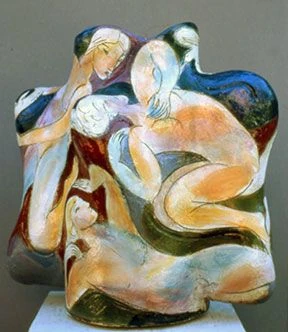
Having been appointed to establish a new ceramics department at the Otis Art Institute in Los Angeles, Voulkos quit The Bray in 1954, just as his reputation as a ceramist was beginning to soar.
Many other notable artists passed through The Bray during those years, either as artists-in-residence or to conduct workshops, including Rex Mason, Marguerite Wildenhain, who was a student of Frances Senska’s, Tony Prieto, Carlton Ball, and others. Rex Mason, Marguerite Wildenhain, who was a student of Frances Senska, Tony Prieto, Carlton Ball, and others.
A couple more years passed, and Autio continued to direct the residences and work on more architectural pieces. He moved to California in late 1956, with his two children and a third on the way, in search of more stable and lucrative career opportunities. As things didn’t work out for him, he returned to Helena in the spring of 1957, just in time to find that Carl McFarland, president of the University of Montana, was looking for someone to establish a ceramics department in Missoula.
Originally from Pullman, Washington, Autio received and graduated with a Master of Arts degree from Washington State University. Autio was one of the first resident artists at the Archie Bray Foundation, which opened its doors in 1952.
Autio founded the ceramics department at the University of Montana, in Missoula, in 1957. He died in 2003. For the next twenty-eight years, he taught at the university, where he remained until his death as Professor Emeritus.
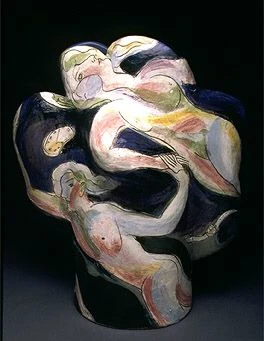
In the summer of 1958, Peter Voulkos came to campus on the invitation of Autio and worked as a visiting artist. The two collaborated on the development of various clay bodies using clay and sand that had been excavated locally. They each created pots and sculptures that were expressionistic.
Jim Melchert was one of their summer students at the time. He wowed everyone with his imagination, brilliance, and curiosity, and he would go on to have a storied career as an artist and a professor.
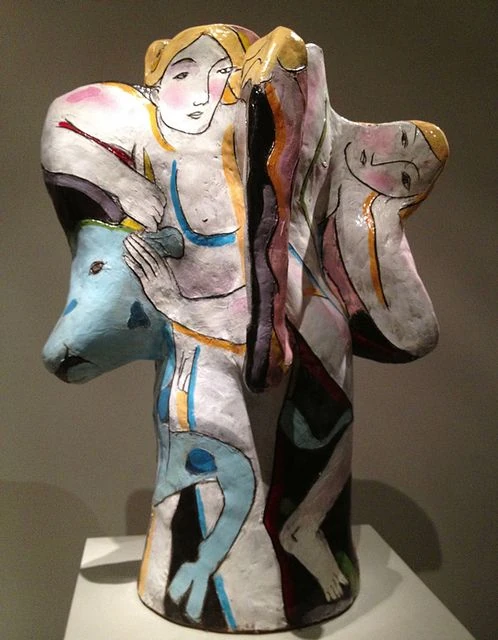
In the years following his appointment as a member of the University of Montana’s faculty, Autio continued to create public artworks in clay and other media. He designed and built the 8-foot-tall, 5000-pound bronze Grizzly sculpture for the school.
Autio traveled to Finland numerous times, where he taught classes at the Arabia Porcelain Factory in Helsinki and the Applied Arts University in Helsinki, Finland, created work for exhibitions, and reconnected with long-lost family and friends.
He produced a stoneware tile mosaic for the inside of the Wells Fargo Bank in Helena that is 6.5 feet by 70 feet. In addition to massive freestanding abstract sculptures made of cement and steel, he also created works for various public spaces.
The characters and animals on Autio’s torso-shaped vessels are painted in a free linear style reminiscent of Matisse’s works on the vessels’ torsos.
Rudy Autio Legacy
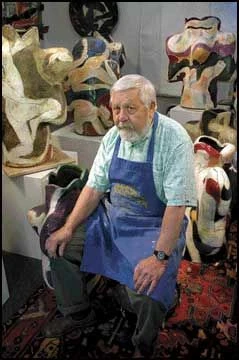
He is a Fellow of the American Crafts Council, an Honorary Member of the National Council of Education in the Ceramic Arts, and a holder of an honorary Doctorate of Art from the Maryland Institute, College of Art in Baltimore, among others, honors and distinctions. In ceremonies held at the Mint Museum in Charlotte, North Carolina, in November 1999, he was presented with the American Craftsman’s Gold Medal Award.
Autio is most recognized for his figurative ceramic vessels, he has created work in a wide range of materials and other media during his career. Additionally, he has completed commissions in ceramic relief and tile murals, as well as work in bronze, concrete, and glass. He has also designed and constructed metal sculptures, as well as colorful Rya tapestries. These were all commissioned for public buildings in the Northwest.
Autio has continued to create large-scale, site-specific architectural murals for a variety of structures around the region’s metropolitan area.
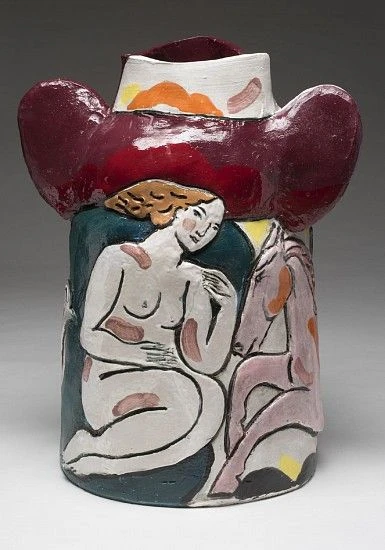
He became interested in bronze casting in the early 1960s and worked with it over the next many years, beginning in the early 1960s. After being approached by the University of Michigan for a commission to make a life-sized bronze grizzly bear for the campus oval, he accepted the challenge, which turned out to be far more difficult and time-consuming than he had anticipated.
Along with architectural projects (Great Falls to mention one), Autio explored sculpture in cement, steel, and glass. He made relatively little work in clay during the 1960s and early 1970s, except for a few architectural commissions.
Slowly but steadily, he found himself lured back to the medium of ceramics, thanks in large part to the support of contemporaries and former pupils who had gone on to have distinguished careers in the field.
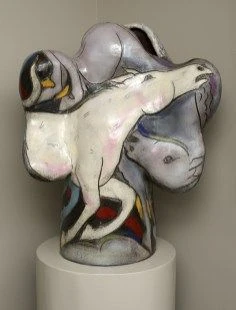
Both David Dontinghy and Jim Stephenson were students at the time. Later, the two would reconnect as instructors at Penn State, where they were responsible for the creation of the national Supermud ceramic conferences, which were essential in advancing the credibility and appeal of the medium.
Doug Baldwin, Fred Wollschlager, Jay Rummel, David Askevold, Martin Holt, and Beth Lo were among the other students who attended. When Autio retired from the University of Montana in 1985 ( where he taught for 28 years ), Lo would eventually take over the teaching job he had left vacant at the time of his retirement.
Museums
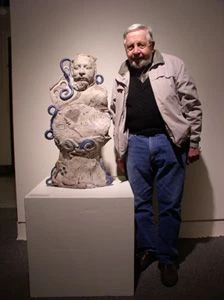
Autio’s life works (masterful works and impressive array) can be found in the permanent collections of museums all over the world, including:
- Boston Museum of Fine Arts
- Brooklyn Museum
- Carnegie Museum of Art
- Metropolitan Museum
- Montana Museum of Art and Culture
- Museum of the Rockies
- Nelson-Atkins Museum of Art
- Renwick Gallery of the Smithsonian Institution
- Applied Arts Museum in Helsinki
- Canton Museum of Art
- National Museum in Stockholm
- Portland Art Museum
- Museum of Contemporary Art
- Missoula Art Museum
- Yellowstone Art Museum (Autio Collection)
- During a new exhibition of their artworks, curated by their children and on show at the Yellowstone Art Museum through Oct. 3, Rudy & Lela Autio, the artistic husband and couple whose legacy is etched across Montana, are remembered fondly. The two met while attending college in Bozeman, Montana, in the 1950s, when they were both involved in the modernist art movement in the state.
- It was clear that they had quite different attitudes to creation, and while Rudy’s work took center stage on many occasions, they maintained a solid cooperation that pushed both artists into worlds of their own creation.
- In the ceramics world, Rudy was recognized for his large-scale vessels and paintings of figurative ladies, earning him the nickname “the Matisse of ceramics.” In his pottery and mythology, he included elements of Greek culture and mythology into his Western scene, whereas Lela’s art celebrates a vividly colorful and wacky vision.
- In addition to developing a “soft sculptures” technique that evolved into working with acrylic glass, Lela was also inspired by the technicolor vibes of the Beatles’ Yellow Submarine to create her works of art.
- 75 pieces from the family’s private collection are on show, spanning Rudy’s career from the 1950s to 2006, a year before his death, as well as works done by Lela up to 2012, which are included in the exhibition.
- It was a year after she received the Governor’s Art Award (First recipient of the Governor’s Award) that she passed away. Among the initial recipients of the honor, Rudy was one of the state’s youngest, receiving it in 1981.
- Holter Museum
- Louis Art Museum
- Shigaraki Ceramic Museums
- American Craft Museum
- Rago Arts Auction Center
- Eastern Montana Casino
From the Louis Comfort Tiffany Foundation for Crafts in 1963 (In 1963, Autio was awarded the Tiffany Award for Craftsmanship.), the American Ceramic Society’s Art Award the following year in 1978, and a grant from the National Endowment for the Arts in 1981, Autio garnered recognition for his work.
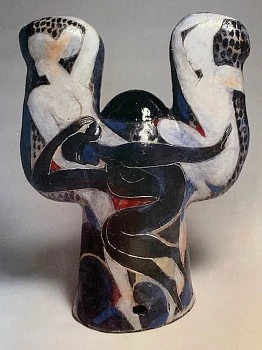
In addition, the State of Montana presented its first Governor’s Arts Awards in 1981 (local news), with Autio being named Outstanding Visual Artist of the Year. While his early pots were inspired by abstract expressionism, he is best renowned for his figurative work from the 1960s and 1970s. He layered spontaneous drawings of people, landscapes, and animals on top of anthropomorphic clay forms to give his vessels a graphical quality (add pictorial qualities) that was previously lacking. His technique superimposed improvisational drawings on his vessels of landscapes, animals and women for a very unique artwork ahead of his time.
He was inducted into the American Craft Council’s College of Fellows in 1978, and the American Craft Council awarded him the Gold Medal for Consummate Craftsmanship in 1999, which is the highest award given by the Council and one of the most prestigious in the country.
Autio lived in New York City with his wife and two children. In 2007, the James Renwick Alliance presented him with the Masters of the Medium honor for his work.
He was named an honorary member of the National Council on Education for the Ceramic Arts and was awarded an honorary Doctorate of Fine Arts from the Maryland Institute, College of Art in Baltimore, among other accolades.
Autio has been dubbed the “Matisse of ceramics,” and it is clear that the artist has been influenced by Matisse’s work in much of his work. It was he who allowed the influences of his life his interests, passions, and experiences to inform and imbue his art-making. Matisse is in attendance. Picasso is in attendance.
Peter Volkous, Frances Senska, and Shji Hamada are all in attendance, as well. Lela Autio is always there for you. Charlie Russel is in attendance. Montana, as well as ancient Greece, can be found there. Finntown is right around the corner.
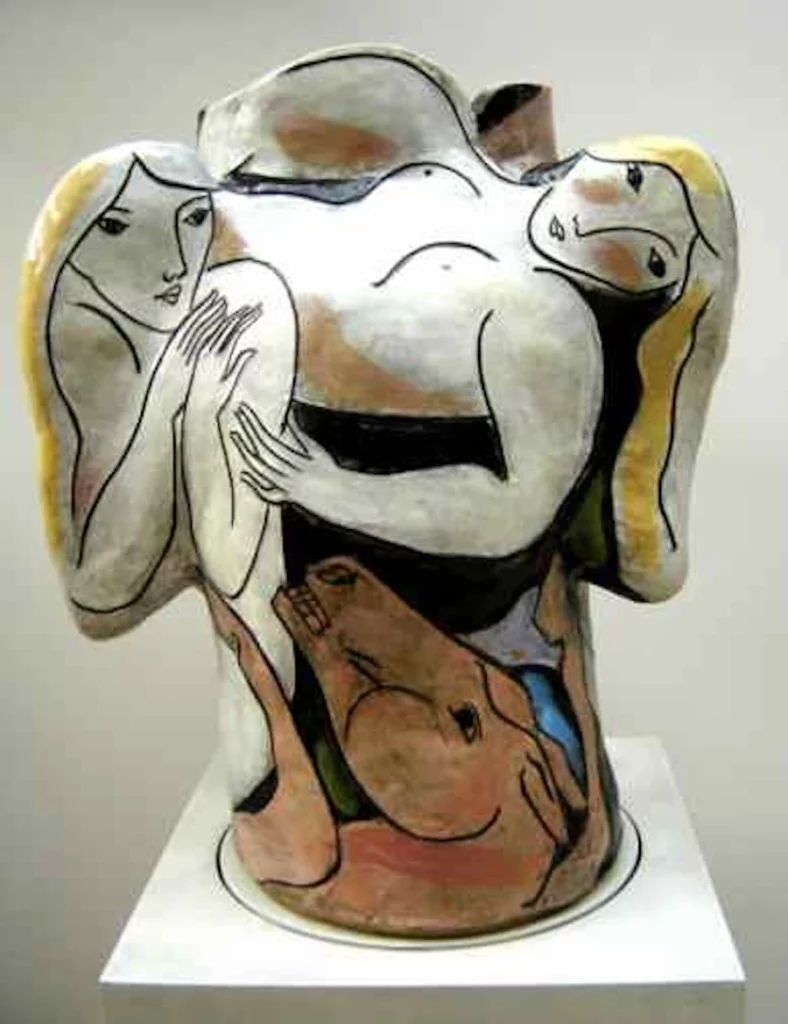
In addition to all of these influences, there is something that is entirely and totally Rudy Autio’s that draws them all together and holds them together. His body of work is extensive.
It possesses both width and depth. It provides a plethora of resources. At the same time, it is extremely peaceful, quiet, and even humble, which is reminiscent of the artist’s demeanour.
According to Michael Rubin’s foreword to Rudy Autio Work 1983 to 1996, “Rudy Autio Work 1983 to 1996” is a collection of his work from 1983 to 1996 “. In Rudy Autio’s ceramic art, there’s a quiet knowledge about it.
Testing, observation, and the option to repeat or discard, as well as shifting the hue and thickening the line, all contribute to the development of a mature vision. His calm, soft spoken demeanor, much like his paintings, can be deceptive as to his great commitment to his craft.
One undeniable thing is the enormous impact Autio has had, and in many ways continues to have, on the area of contemporary ceramic arts in his roles as visionary, and artist.
Rudy Autio’s Associations
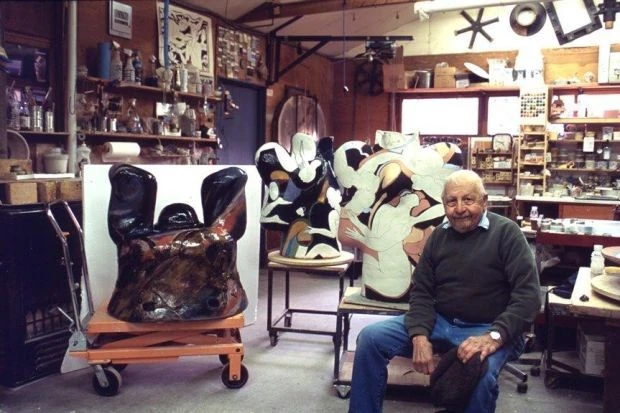
Akio Takamori
Akio Takamori was a ceramic artist who was born in Japan and raised in the United States. He was a professor at the University of Washington in Seattle, Washington.
Jun Kaneko
Jun Kaneko is a Japanese ceramic artist based in Omaha, Nebraska, in the United States. He has shown internationally. His ceramic sculptures investigate the effects of recurring abstract surface motifs on the viewer.
Kensuke Yamada
Originally from Japan, Kensuke Yamada studied at Evergreen State College in Olympia, Washington, where he obtained his bachelor’s degree in arts and sciences. He continued his ceramics education at the University of Montana, where he graduated with a Master of Fine Arts degree in 2009. He is currently employed as an instructor at the University of Arkansas at Little Rock, in Arkansas.
Louana M. Lackey
She was a ceramics historian and archaeologist who worked in the field of ceramics. She was born Louana Mae Engelhart in Champaign, Illinois, and received a Bachelor of Arts degree from American University in Washington, D.C., as well as a doctorate. The work of modern ceramic artists was researched and written about by Dr. Lackey, who traveled to Central America, Spain, and Italy to interview potters. The Journal of the National Council on Education for the Ceramic Arts published one of her scientific pieces, which was published in American Antiquity, American Ceramics, British Archaeological Reports, Ceramics Monthly, and Journal of the National Council on Education for the Ceramic Arts. Among her many publications are The Pottery of AcatlM-an: A Changing Mexican Tradition and a biography of ceramic artist Rudy Autio, who died in 2011. A former president of the National Council on Education for the Ceramic Arts, she was a pioneer in the field.
Patti Warashina
Patti Warashina is a ceramic artist from the United States who is well-known for her innovative porcelain sculptures. Warashina’s sculptures are frequently made of porcelain, and her work is both narrative and figurative in nature.
Henry Meloy
Henry Meloy was born in 1902 in Townsend, Montana, but he spent the majority of his professional life in New York City. In 1923, he entered in the Chicago Art Institute to study painting and drawing, and he graduated in 1927. In 1926, he relocated to New York City to complete his studies at the National Academy of Arts under the tutelage of artist Robert Henri, who became his mentor. In 1927, he transferred to the Art Students League, where he graduated in 1929 after largely studying under John Carroll’s guidance.
In the fall of 1940, he accepted a position as a painting and drawing instructor at Columbia University. This was also the time period in which Meloy traveled to Montana and collaborated with his brother, Peter, who would go on to assist in the founding of the Archie Bray Foundation for the Ceramic Arts, which was established in 1951.
Meloy continued to teach at Columbia for the next decade, until his unexpected death in 1951 at the age of 49, at the age of 49. In addition to the Metropolitan Museum of Art, his work is featured in the permanent collections of the Brooklyn Museum of Art and the Metropolitan Museum of Art.
Ken Little
Ken Dawson Little was born in Canyon, Texas, in 1947, and is a modernist sculptor who lives and works in San Antonio. After earning a BFA in painting from Texas Tech University in 1970, he went on to earn an MFA in painting from the University of Utah in 1972. His enthusiasm in painting began to diminish, and he began to pursue pottery instead.
Robert Turner
American potter Robert Chapman Turner was best recognized for his functional pottery, sculptural containers, and inspirational teaching. He died in 2003. Swarthmore College, where Turner received his Bachelor of Arts degree in 1936, was his first stop after graduating from high school in Port Washington, New York.
Walter Hook
Walter Hook was born and raised in Montana and was a painter and printer. A master’s degree in art from the University of New Mexico was awarded to him in 1950. He then went on to be appointed as chair of the art department at the University of Montana.
Don Reitz
Donald Lester Reitz was an American art ceramic artist who was credited with reviving the craft of salt glaze ceramics in the United States. He died in 2003. From 1962 through 1988, he worked as a ceramics instructor at the University of Wisconsin–Madison in Madison, Wisconsin.
Paul Soldner
Mr. Paul Edmund Soldner was a ceramic artist and educator from the United States who is most known for his experiments with the 16th-century Japanese technique called Raku, which he pioneered by developing new ways of fire and post-firing that became known as “American Raku.” In 1966, he was the driving force behind the establishment of the Anderson Ranch Arts Center.
Images pinterest = Rudy Autio





